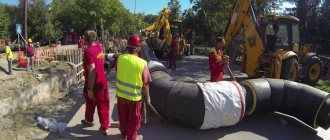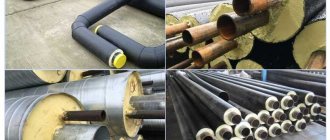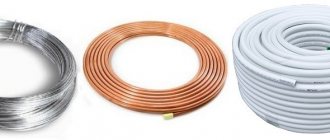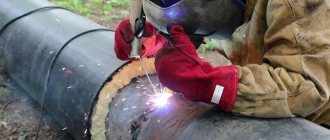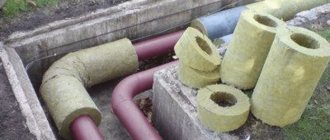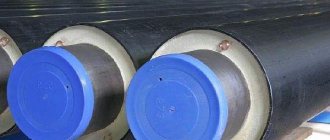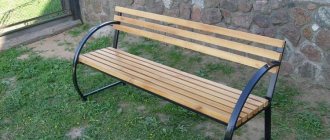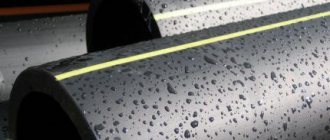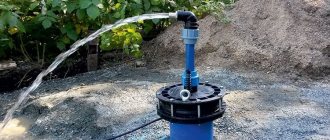PPM pipe is used to protect the pipeline structure from environmental influences and other negative factors. Such protection is one of three types of pre-insulation, which are widely used when laying pipelines for various needs. The excellent performance characteristics and fairly long service life of this composite material make it possible not only to minimize the percentage of heat loss, but also to protect the pipeline structure from mechanical damage.
Pipe in PPM insulation is a type of pre-insulated product used for installation of heating mains
What is PPM insulation
It is a material based on polyurethane components and mineral filler. When laying pipelines, metal products are often insulated to reduce heat loss. In their work, enterprises use the set of rules No. 124.13330.2012 based on SNiP “Heat networks”, which specifies the requirements for laying underground ductless heating networks.
Pipes with PPM insulation
The need for choice for the customer
At the moment, there are quite a lot of types and methods of thermal insulation of heat pipes. This is a “pipe in pipe” system with PPU insulation, and insulation of heat pipes using PPU shells, and “Isoflex”, many still insulate pipes using mineral wool and various types of coating on it, there are backfill structures using water-repellent insulated fine materials , the method of spraying foaming systems is often used, and PPM structures are gradually becoming widespread.
It would be wrong to give preference to any one type of insulation for all occasions. It turns out that if you take any type of insulation from the above, evaluate the possibilities and feasibility of its use in specific conditions, and carry out the work without violating the technology, it turns out that they all have the right to life.
Characteristics and properties of the material according to GOST
The table shows the indicators:
| Index | PPM insulation |
| Thermal conductivity value | 0.044 W/(m-°C) |
| Volumetric mass | 250 ± 50 (insulation layer -100 kg/m3) |
| Compressive strength | 1.2Mpa |
| Heat resistance | 150 degrees |
| Mandatory continuous remote monitoring of insulation moisture | Not required |
| Maintainability | Can be repaired |
| Protection against mechanical damage | No need to install protection from external factors |
| The stability of the material, how quickly it dries after moisture appears. Another name for the indicator is vapor permeability. | Drying occurs quickly, the insulation can withstand moisture. |
| Fire hazard | The material is not dangerous; if you try to set it on fire, it goes out on its own. |
| Toxicity | The layers use environmentally friendly materials. |
| Relation of material to corrosion | The initial medium has a neutral pH |
The production of PPM protective layers for equipment is being improved, which makes it possible to improve its performance characteristics. Due to the low vapor permeability, less dripping moisture penetrates into the insulation. Due to this, the quality characteristics of the material remain high. There is no caking, no loss in strength of the composition used.
Strengths and weaknesses of thermal insulation made from mineral-polymer foam
Foam-polymer-mineral thermal insulation has some operational advantages compared to other pipe insulation. This mainly stems from its special qualities.
List of main advantages of using PPM insulation:
- PPM pipe insulation is not afraid of aging. The operating time does not affect the material thickness parameters in any way.
- The water absorption coefficient of the material is at a very low level.
- Very weak thermal conductivity. This makes it possible to reduce heat losses in main heating networks and water pipelines to a minimum: generally, the percentage of heat losses does not exceed 4%. In terms of this indicator, PPM insulation is several times higher than mineral wool.
- The material is cheap when compared with other options for pipe insulation (for example, with polyurethane foam).
- Thanks to the foam-polymer-mineral shell, the service life of pipelines is increased by approximately 30 years.
- By installing this insulation, the cost of maintaining the highway is significantly reduced. This also leads to a reduction in the number of accidents.
- If leaks occur in the pipeline, this will not in any way affect the quality of the foam-polymer-mineral shell: after drying, it will be ready for use again.
- There is no need to install a system for operational remote monitoring of the SODK, which monitors the condition of thermal insulation.
It is also worth mentioning certain disadvantages of mineral-polymer foam insulation:
- Due to the large weight of the material, the prices for its transportation increase. To install the shells, you have to use special equipment.
- The level of heat loss exceeds similar systems that use polyurethane foam shells.
- PPM insulation is not able to provide complete tightness, therefore, to protect the pipeline from corrosion, the use of special anti-corrosion agents will be required.
Main components
*
Polymer mineral foam material belongs to the group of rigid polyurethane foams. This is foamed raw material into which a mineral filler is introduced. Ash or sand is used as the latter. There is no chemical reaction between these components. After mixing the polymer and mineral filler, the end result is a simple mixture.
As a rule, the composition includes polymer components and fine filler. It is this set that allows the final product to combine the properties of two materials into one:
- Polyurethane foams;
- Polymer concrete.
This reduces the consumption of raw materials and the final cost of the final product. When mineral and other additives are included in the composition, highly filled systems are formed. The properties of the final product are significantly improved:
- Physico-chemical;
- Thermal-physical;
- Technological;
- Anti-corrosion.
PPM insulation, to improve certain characteristics, may contain a synthetic base and various mineral fillers, which leads to a change in product modification.
Pipes with PPM sheath
[edit] Construction
The front part of the PPM-88 consists of a volumetric type mask with panoramic glass, an independent seal (molded as one piece with the mask body), a mask holder, an intercom, inhalation and exhalation valve assemblies and an adjustable headband. A design feature of the PPM-88, unlike other front parts of filtering gas masks, is the presence of a mask lining, which prevents fogging of the panoramic glass and reduces the carbon dioxide content in the inhaled air due to the fact that the exhaled air does not come into contact with the panoramic glass and directly enters the exhalation valve assembly . The mask provides good audibility and speech intelligibility. It has a threaded connection 40x4 mm (GOST 8762-75) and is compatible with all filters with similar threaded connections..
Benefits of use
When using it, certain advantages are noted when compared with other products that perform insulating functions on pipelines. The benefits largely depend on the properties of the material.
Positive aspects of using the pipeline insulation in question:
- Over time, the physical characteristics of the material do not deteriorate. There is also no reduction in the thickness of the applied layer;
- A pipeline dressed in such clothing has a low absorption coefficient;
- Low thermal conductivity, due to which large heat losses do not occur in the main line. Conducted experiments show that, being in a shell made of foam-polymer-mineral insulation, pipes lose no more than 4 percent of heat. If we draw parallels with other insulating materials, for example, mineral wool, then here the thermal conductivity is higher and heat loss is increased by 2-3 times;
- The price of this type of casing for highways is significantly lower than other conventional heat preservation technologies;
- the service life of pipelines has been increased and is more than 30 years;
- pipelines with a polymer coating function longer without repairs or accidents, which significantly reduces the cost of maintaining and servicing pipelines;
- after a pipe breakthrough, there will be no deformation of the casing. The insulation will dry and continue to perform its functions;
- Sensors are not installed on the pipelines to quickly monitor the condition of the insulation layer.
Production nuances
The mold for pouring the mass is a hollow cylinder with a fixed lower part and an opening upper part. Both halves are equipped with special seals that provide the required level of tightness. The cost of PPM pipes can fluctuate, which is influenced by their size, thickness and density of the heat-insulating layer. Also, products from well-known manufacturers usually have a higher price, with an excellent level of product quality. When calculating the cost of an insulating material, its thickness, pipe diameter and product length are taken into account. In addition, transportation and laying of the material will be a separate expense item, which will require special equipment.
Foam-polymer-mineral pipes are characterized by very high efficiency: with their help, a variety of heating networks and water pipelines are installed that transport hot water to the consumer. The price of these products may vary, which is influenced by the design features of the pipe and mineral-polymer foam insulation. The organization of main pipelines in this way has an excellent economic effect. It is also important to understand that PPM communications do not require preventive inspections if their service life is very long. At the same time, the thermal insulation characteristics of the PPMI pipe are completely independent of how much time has passed since its installation.
These communications can be established using both open and open methods. Due to their hydrophobicity and excellent strength properties, foam-polymer-mineral pipes are extremely popular, which allows them to maintain a very high position in the ranking of similar products. When purchasing products, it is important to request accompanying documentation and a quality certificate indicating testing after manufacture. As for installation work, due to the significant weight, it is better to resort to the help of special laying equipment and a team of experienced specialists. If the installation is carried out in compliance with all necessary standards, then no special costs will be required for maintenance and inspection of the main line.
Application area
Massive use as a heat-insulating material is observed in the construction of heating mains. This occurs on the basis of regulatory documentation, in which the specified insulation is included in the “representative structures of heat pipelines”. In particular, in the set of rules developed for ductless installation of heat supply networks, there is a precise indication of this technology.
Pipes do not always come with a protective layer applied; in this case, it is done independently by pouring directly at the installation site. The maximum heating temperature of the material is allowed, up to 150 degrees, at the specified coolant temperature.
If the pipeline runs on the surface of the earth, then it is necessary to install an additional layer on top that protects from ultraviolet rays. This can be either a separate layer or additives with special UV absorbents.
Products
Installation technology
*
Insulation is applied to the pipe from the outside. In this case, the foam-polymer-mineral shell consists of three layers:
- the first cover consists of a material that protects the line from corrosion. Made up to 10 mm thick;
- Next comes the main layer, which is responsible for retaining heat;
- The last and outmost layer is the layer that protects the pipe from mechanical damage. The layer is denser than the coatings located underneath it. Here the thickness can reach 15 millimeters
Layers
Application is carried out on products with a diameter of 32-820 millimeters and a length of up to 12 meters. How the pipe is produced does not matter. This can be seamless or welded. In the production of metal structures, GOST 8731, 10704, 8733, 20295 are used.
A layer with thermal insulation properties is applied not only to straight sections of the pipeline. To obtain a highly efficient main line that will deliver heat to homes with minimal losses, it is necessary to be completely covered. To do this, the layers are laid on the following connecting parts:
- adapters between pipes;
- branches necessary for branching to houses;
- tees, other shaped parts that can be used when laying heating mains.
Insulated connecting parts
For information on how to properly seal seams at pipe joints, see the exact installation instructions for the specified products.
How pipe products are produced
The foam-polymer-mineral shell has a monolithic structure and is applied to the pipes during manufacturing. Pipes with cross-sectional dimensions of 57-820 mm are equipped with shells 32-88 mm thick. Due to its adhesive properties, this polymer material provides an excellent level of thermal insulation for highways. The production of these pipes is characterized by the formation of three insulating layers, each of which is characterized by certain qualities. The density of these layers is also different. With the help of PPM protection, pipelines are able to withstand the most difficult operating conditions.
A pipe with polymer-mineral foam protection is produced in the following stages:
- Preparation of foamed polymer and mineral additives (ash, sand or slag).
- Preparation of a steel pipe or shaped element that will be equipped with a thermal insulation layer.
- Pouring polymer-mineral foam into a mold where a centered steel pipe has been previously installed.
- Upon completion of applying PPM insulation, the finished pipe is tested.
When pouring the PPM substance into the workpiece, some stages are also observed. First, the percentage of the constituent components is determined and measured
When making calculations, it is necessary to take into account a number of factors - insulation thickness, pipe cross-section parameters, etc. When the calculations have been carried out, the individual components are carefully dosed and mixed, after which the finished mass can be poured into a mold where a centered pipe is already located.
Life time
When the pipe, hidden in the PPM, is insulated from external influences by foam-polymer-mineral mass, its service life increases and reaches 30 years. There is no need to install state controllers. The pipe is reliably protected from corrosion and freezing. The protective layer also retains its physical properties unchanged for the specified period.
The manufacturer provides a guarantee for the pipeline of 30 years.
Pipes with PPM insulation
*
Description of pipeline design in PPMI
Foam-polymer-mineral insulation is a superficially closed cellular structure made of polyurethane foam with mineral additives, which consists of:
- outer dense waterproof layer;
- middle porous layer;
- dense layer adjacent to the surface of the pipe.
All layers are made of homogeneous foamed polymer material.
Mineral additives included in the structure of polyurethane foam significantly increase its strength without changing its density. The dense outer layer is very rigid and can reliably protect the remaining insulation from mechanical damage during underground pipeline installation.
The surface layer does not allow moisture to pass through and not only prevents the middle layer from getting wet, but also reduces corrosion of the pipe metal during operation. The insulation does not cake and does not lose its properties over time.
We recommend that you read: Features of the use and installation of metal-plastic pipes
In addition to straight sections of pipes, the industry produces shaped elements, also insulated using PPMI. These are elbows with different angles of rotation and tees for branching flows.
Features of operation
The use of metal products that are wrapped with PPM insulation allows installers to solve a lot of problems that invariably arise during the construction and subsequent use of networks. However, before installing the pipeline, you should be aware of certain nuances that may arise during operation:
- reliable waterproofing function is present only on the top layer;
- the dielectric value of the metal can cause the loss of the protective layer due to its premature destruction. Therefore, before applying insulation, it is necessary to degrease the surface of the pipe; it is necessary to remove dissolved oxygen, hard salts, and contamination;
- In places where the pipeline is located above ground, the condition must be checked more often. For this purpose, a check order is established.
The check contains the following items:
- safety of the insulation layer;
- if the PPM insulation used for pipes is painted, this means the integrity of the helmet coating;
- The pipeline line is checked. Intermediate and inspection wells are inspected.
Laying a pipeline with PPM insulation

